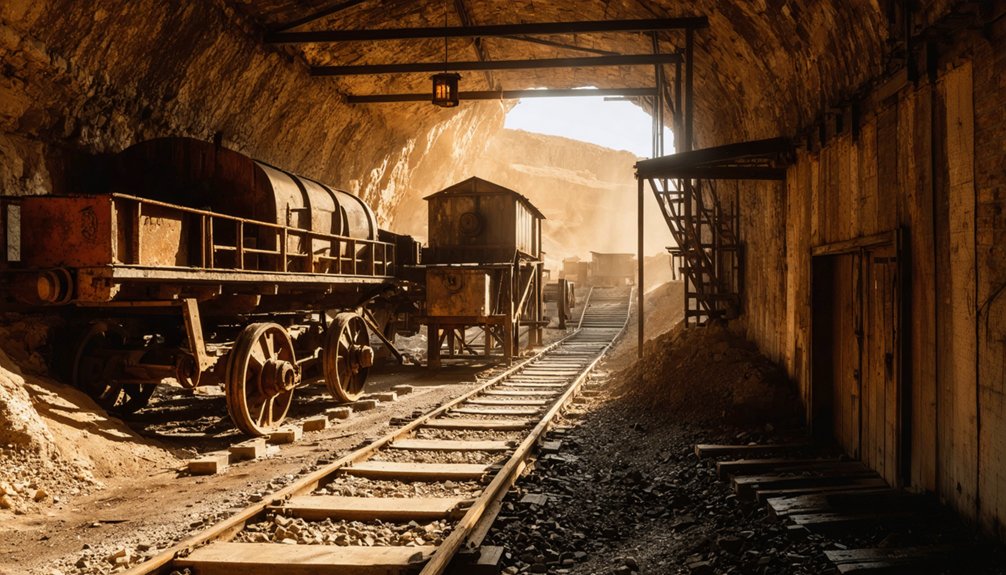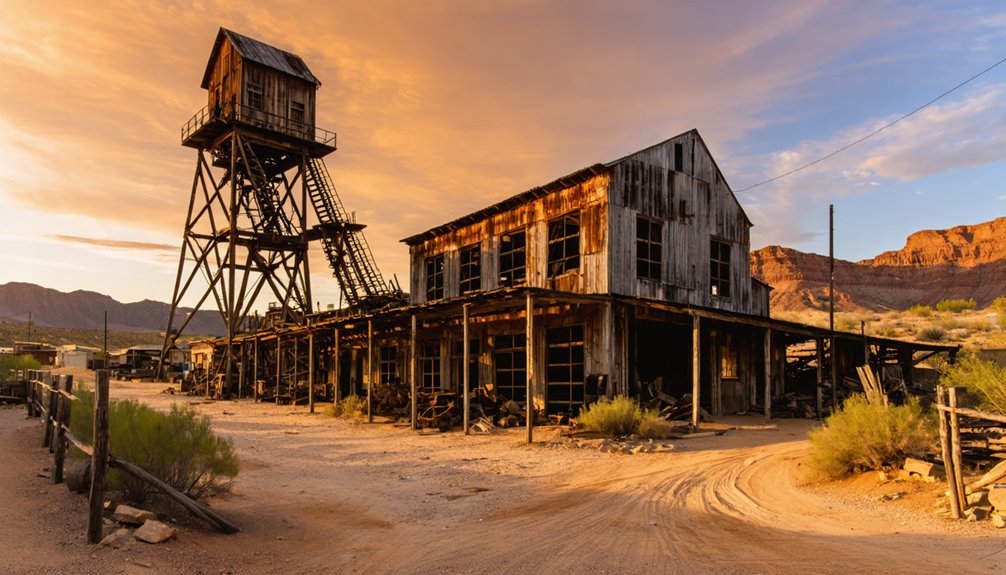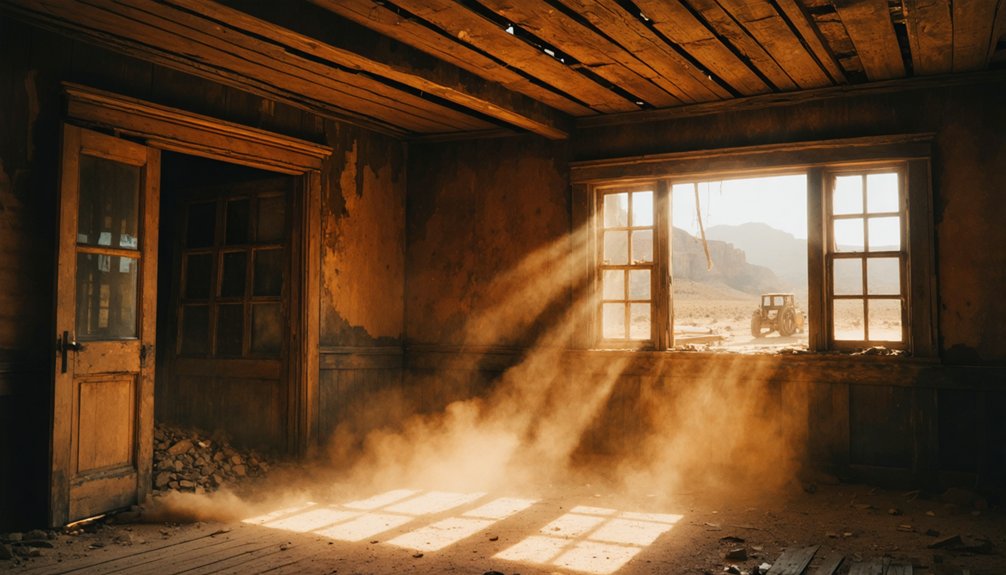Vulture City emerged after Henry Wickenburg’s 1862 gold discovery, developing into Arizona Territory’s richest mining settlement with a population of nearly 5,000. You’ll find remarkably preserved structures including an 80-stamp mill, blacksmith shops, and Wickenburg’s cabin from its 1860s-1940s heyday. The town’s sudden closure during World War II left buildings abandoned until recent preservation efforts. This desert ghost town‘s Hanging Tree and original mining equipment reveal Arizona’s boom-and-bust frontier story.
Key Takeaways
- Vulture City emerged after Henry Wickenburg’s 1862 gold discovery, developing into a thriving mining town with nearly 5,000 residents.
- The Vulture Mine produced over $30 million in gold during its operation, becoming Arizona’s largest and richest mine by the 1860s.
- Daily life centered around mining operations, with community infrastructure including homes, saloons, shops, and the infamous Hanging Tree.
- World War II regulations forced the mine’s closure, causing mass unemployment and eventual abandonment of the settlement.
- Preservation efforts begun in 2017 saved 18 original buildings, transforming Vulture City into a tourist destination showcasing Arizona’s mining heritage.
The Discovery of Gold: Henry Wickenburg’s Fortune
Few frontier discoveries shaped Arizona’s territorial development more profoundly than Henry Wickenburg’s 1862 gold find. While returning from an expedition to the Harquahala Mountains, Wickenburg spotted a distinctive white quartz outcropping near the Hassayampa River that caught his experienced eye.
Following his instincts, he returned to investigate alone, discovering gold-laden samples that validated his suspicions. The German immigrant, born as Johannes Henricus Wickenburg, had arrived in Arizona just a year before his momentous discovery. Wickenburg’s discovery soon attracted his former companions, resulting in the establishment of the Vulture Mine.
Driven by miner’s intuition, Wickenburg unearthed golden treasures that would transform Arizona’s frontier landscape forever.
Initial processing using a primitive arrastra yielded promising returns, confirming the site’s potential. Though Wickenburg later sold 80% of his interest for $85,000, he reportedly received only $25,000 due to title disputes. The mine proved incredibly valuable, producing over $30 million in gold during its operation.
Despite these challenges, his mining claims became the foundation for both Vulture City and the town bearing his name, creating a lasting legacy in Arizona’s history.
From Barren Desert to Boomtown: The Birth of Vulture City
While Henry Wickenburg’s discovery of gold laid the groundwork for what would follow, the transformation of this remote Arizona Territory location into a thriving settlement stands as a tribute to human perseverance against harsh desert conditions.
You’ll find that Vulture City overcame water scarcity through remarkable desert innovations. The completion of the Vulture Pipeline in 1880 transported water 15 miles from the Hassayampa River, enabling sustainable growth. By the late 1800s, the mining community had grown to include almost 5,000 residents.
The town rapidly expanded with:
- An 80-stamp mill crushing ore amid offices and warehouses
- Revitalized Native American canal systems supporting agricultural practices
- A 12-acre garden producing food for 150 initial workers
- Essential services including assay offices, blacksmith shops, and schools
The mine became the largest and richest in Arizona by the late 1860s, attracting investors and workers from across the territory.
Life in Arizona’s Richest Gold Mining Town
As Vulture City reached its apex in the late 19th century, it transformed from a rudimentary mining camp into Arizona Territory’s quintessential gold boomtown, supporting a diverse population of up to 5,000 residents.
Daily life revolved around the mine that yielded an astounding 340,000 ounces of gold and 260,000 ounces of silver—worth approximately $200 million today.
Community dynamics centered on practical necessities: you’d find men laboring at the 60-80 stamp mills while others maintained the blacksmith shops, cookhouses, and assay offices. The mine was originally discovered by Henry Wickenburg during California’s gold rush in 1863. The town included numerous saloons, reflecting the frontier lifestyle that characterized the rugged spirit of the Old West. The town’s cultural resilience manifested in its self-sufficiency, evidenced by the 12-acre garden that fed 150 miners daily.
Despite harsh desert conditions, residents established infrastructure that included stone buildings, boarding houses, stores, and a post office—creating a functioning society that ebbed and flowed with the mine’s fortunes.
The Hanging Tree: Frontier Justice and Lawlessness
When you visit the infamous Hanging Tree at Vulture City, you’ll encounter a stark symbol of the swift, merciless frontier justice that defined this lawless mining community.
The ironwood tree served as the execution site for eighteen men, primarily “high graders” who dared to steal the mine’s precious ore during a time when theft reportedly accounted for up to half of all extracted gold. Henry Wiberg’s cabin, built in 1864, stands as a silent witness near this grim historical landmark. Many of these tales were fabricated for tourism, creating a mythological history that exaggerated the actual events.
Bodies would hang for hours before death in the scorching Arizona sun, their remains sometimes left as grim warnings to others who might consider similar crimes in the absence of formal law enforcement.
Swift, Brutal Justice
In the lawless expanse of Vulture City’s mining heyday, justice arrived swiftly at the end of a rope. With no formal authorities present, vigilante justice reigned supreme, centering around an ironwood tree near Henry Wickenburg’s cabin. Here, miners executed those who threatened their livelihood, particularly high-graders who stole precious ore.
- Bodies swayed in the desert heat for days, decomposing before burial in unmarked graves.
- Victims kicked from rocks or mules suffered slow, agonizing deaths lasting hours.
- Approximately 18 men met their fate at this tree, creating enduring ghostly legends.
- Executions served as brutal warnings—steal from the mine, pay with your life.
The lawlessness reflected the reality of a boomtown that once housed 5,000 residents during Arizona’s most profitable gold mining operation. Today, these grim tales of frontier justice contribute to Vulture City’s mystique, where visitors still report paranormal encounters near the notorious Hanging Tree. While many report hearing voices in German during paranormal investigations, historians remain skeptical about the authenticity of these hanging accounts.
Thieves’ Final Fate
The infamous Hanging Tree, a gnarled ironwood standing sentinel outside Henry Wickenburg’s cabin, served as Vulture City’s unofficial gallows where approximately eighteen men met their fate.
When caught high-grading—stealing precious ore—thieves’ remorse came too late as vigilante justice swiftly condemned them without trial.
After execution, bodies dangled for hours as warnings before being cut down. Though folklore suggests victims were buried near the tree, evidence indicates they were interred elsewhere on the property—not in the children’s cemetery but in unmarked graves, their locations lost to time.
Today, the tree stands as both monument and cautionary tale. Visitors report ghostly hauntings—disembodied voices and shadowy figures moving through the branches—perhaps echoes of those who died at the hands of frontier justice, their spirits bound to the site of their execution.
Mining Operations and Gold Production Techniques

At Vulture Mine, you’d find workers initially extracting gold using rudimentary methods: picks, shovels, and basic quarrying techniques to separate visible gold from quartz outcrops.
The harsh desert environment created significant water management challenges, requiring the mine operators to establish careful systems for conserving and recycling this precious resource needed for processing operations.
As production expanded beyond the reported 20 troy ounces per ton in early yields, more sophisticated milling and processing techniques were gradually introduced, though these remained constrained by the site’s remote location and limited natural resources.
Primitive Processing Methods
Mining gold at Vulture City began with surprisingly primitive yet effective techniques that reflected the technological limitations of the mid-nineteenth century frontier.
You would’ve witnessed miners attacking exposed gold quartz with nothing more than picks and shovels, breaking ore from surface outcrops by hand. Despite primitive tools and labor intensity, these methods yielded impressive results—up to 20 troy ounces per ton in early extractions.
When processing the valuable ore, miners employed several mechanical separation methods:
- Stamp mills pounding ore to release gold particles
- Sluice boxes washing away lighter materials
- Mercury amalgamation capturing fine gold
- Panning and rocker boxes for small-scale recovery
Later innovations included cyanide leaching, which revolutionized extraction from lower-grade ores and previously discarded tailings, dramatically increasing the mine’s productivity and extending its operational lifespan.
Water Management Challenges
While Vulture Mine’s rich gold veins promised fortune, securing adequate water for mining operations proved nearly as challenging as extracting the precious metal itself. The initial water scarcity necessitated substantial infrastructure investment—a 15-mile pipeline from the Hassayampa River costing $2,400 per mile and requiring six months of labor.
Water sourcing complexities shaped production methods, with early operations placing water-powered arrastras along the distant river. When the Walnut Grove Dam collapsed in 1890, destroying the pipeline, miners adapted by tapping underground water from mine levels and wells. This infrastructure resilience demonstrated remarkable ingenuity despite severe limitations.
Today’s operations showcase dramatic improvements in efficiency, with recent 18% water reductions despite increased production.
Modern closed-loop recycling systems and contamination controls protect groundwater from cyanide and heavy metals while supporting reclamation of the desert environment.
Daily Life and Community in an 1800s Mining Settlement
Life in Vulture City during the 1800s revolved around a surprisingly robust community infrastructure despite its remote desert location. You’d find homes, saloons, a post office, school, and essential services like the butcher who sold an impressive 10,000 pounds of meat monthly.
Community gatherings often centered around the infamous Hanging Tree, which served as both a site for frontier justice and social events.
Daily struggles were constant in this harsh desert environment:
- Miners toiling long hours before seeking respite in saloons and brothels
- Families managing limited resources while facing threats from raids
- Residents relying on vigilante justice in the absence of formal law enforcement
- Community members supporting each other through holiday celebrations and shared meals
The Rise and Fall of Vulture Mine’s Economic Prosperity

When you visit Vulture Mine today, you’re walking on ground that once yielded one of Arizona’s greatest gold bonanzas, producing between $30-200 million in precious metals during its operational life and spurring the development of Phoenix and Wickenburg.
The mine’s prosperity transformed a barren landscape into a bustling settlement of 5,000 residents with schools, shops, and saloons, while generating approximately 340,000 ounces of gold between 1863 and 1942.
This golden era came to an abrupt end when World War II regulations forced operations to cease in 1942, delivering the final economic blow to a mine already struggling with depleted surface ore and operational challenges.
Booming Gold Bonanza
The extraordinary discovery of gold-laden quartz by Henry Wickenburg in 1863 transformed a desolate Arizona desert into one of the territory’s most prosperous economic centers.
This gold rush created an economic powerhouse that yielded an astounding 340,000 ounces of gold and 260,000 ounces of silver by 1942, cementing Vulture Mine’s place in Arizona’s mining history.
When you visit, you’ll appreciate the mine’s remarkable legacy:
- Early operations using simple pick and shovel methods yielded approximately 20 troy ounces of gold per ton
- Daily production reached $700 during initial operations
- The mine’s total value ranged from $30-200 million in historical dollars
- Despite geological challenges, it became Arizona’s most productive gold mine
War’s Economic Deathblow
Despite enjoying decades of prosperity and remarkable gold production, Vulture Mine‘s economic fortunes suffered a terminal blow during World War II when a 1942 presidential executive order mandated the closure of all non-essential gold mining operations.
This federal decree abruptly ended the mine’s 80-year run as Arizona’s gold production powerhouse. While the mine had weathered previous challenges—declining ore quality, flooding at the 310-foot level, and volatile precious metal markets—this government-enforced shutdown proved fatal.
The economic impact rippled immediately through Vulture City as miners and their families departed.
Though operators briefly revived operations post-war, the damage was irreversible. Failed attempts to restore production levels sealed the community’s fate.
What was once a vibrant mining hub transformed into the ghost town you’ll find today—a reflection of how quickly community decline can follow when economic foundations disappear.
World War II and the End of the Gold Rush Era
While World War II dramatically altered America’s industrial priorities, few mining communities felt the impact as profoundly as Vulture City.
President Roosevelt’s 1942 executive order mandated the closure of non-essential mines, redirecting resources toward the war effort. Despite being Arizona’s most productive gold mine, the Vulture couldn’t escape these wartime restrictions.
In wartime America, even Arizona’s golden giant couldn’t outweigh the nation’s industrial priorities.
The economic redirection was devastating for the community:
- 5,000 residents suddenly lost their primary livelihood
- A 79-year legacy of continuous operation abruptly terminated
- Buildings abandoned to the harsh desert elements
- The mine’s $30-200 million economic engine permanently silenced
Though mining operators briefly secured a temporary reopening through appeal, their effort ultimately failed.
When the mine shuttered permanently in 1942, Vulture City’s transformation from thriving community to ghost town was swift and irreversible.
Decades of Abandonment: Vulture City as a Ghost Town

Following the abrupt closure of the Vulture Mine in 1942, an eerie silence descended upon what had once been Arizona’s most vibrant gold mining community.
The town that once bustled with 5,000 residents quickly succumbed to the harsh desert elements. You would’ve witnessed the gradual crumbling of stone buildings—many already demolished during the 1890s when operators recycled materials through their mills.
For decades, Vulture City sat isolated and forgotten. The schoolhouse, blacksmith shop, and brothel deteriorated without maintenance, while ghost town legends flourished in the vacuum of human presence.
Architectural decay accelerated as desert winds, intense heat, and occasional vandals took their toll. What remained was an authentic representation of boom-and-bust mining culture, undisturbed by modern intervention—a genuine relic of Arizona’s gold rush era preserved by its very abandonment.
Preserving Arizona’s Mining Heritage: Restoration and Tourism
As the dawn of the 21st century approached, Vulture City‘s crumbling structures beckoned for salvation from complete erasure. In 2017, private citizens Rod Prat and Robin Moriarty answered this call, launching extensive heritage preservation efforts that saved over 18 original buildings including Henry Wickenburg’s cabin and the town’s brothel.
When you visit Vulture City today, you’ll experience:
- Authentic restoration using salvaged materials from original structures
- Interactive blacksmithing workshops at the historic forge
- Self-guided exploration through genuine mining buildings without excessive regulation
- Haunted flashlight tours revealing the ghostly remnants of frontier life
This preservation initiative has created significant tourism impact, generating local economic benefits while allowing visitors to immerse themselves in Arizona’s rugged mining heritage through seasonal access from October through May.
Frequently Asked Questions
Is Vulture City Haunted or Associated With Any Paranormal Activity?
The hanging tree’s shadow marks your soul’s crossroads. Yes, Vulture City’s renowned for ghostly encounters including shadow figures, disembodied voices, and supernatural sightings at hotspots like the Assay Building and notorious brothel.
What Famous Outlaws or Historical Figures Visited Vulture City?
Horace A. Tabor, the Colorado silver millionaire, owned the Vulture Mine. You’ll find outlaw encounters were common, with notorious bandits targeting gold shipments, highlighting the town’s historical significance in frontier justice.
How Did Residents Cope With Extreme Desert Temperatures?
Baking like desert lizards, you’d adapt by constructing thick-walled stone buildings, wearing loose protective clothing, rationing precious water, and scheduling all activities around temperature patterns—essential desert survival techniques for freedom-loving frontier dwellers.
Were Any Significant Archaeological Artifacts Discovered During Restoration?
Yes, restoration efforts uncovered remarkable archaeological findings including mining tools, household items, and personal belongings. You’ll find these artifacts displayed in situ, providing authentic glimpses into 19th-century frontier life.
Did Any Major Films or Television Shows Use Vulture City as a Location?
Absolutely no blockbuster productions have graced this dusty outpost. You’ll find Vulture City’s film history limited to documentaries and paranormal shows. Location scouting teams from major studios have consistently bypassed these historic grounds.
References
- https://events.thehistorylist.com/organizations/vulture-city-ghost-town
- https://www.legendsofamerica.com/vulture-city-arizona/
- https://vulturecityghosttown.com/history/
- https://www.abandonedamerica.us/vulture-city
- https://www.visitarizona.com/directory/vulture-city-ghost-town
- https://cactusatlas.com/adventures/vulture-mine/
- https://vulturecityghosttown.com/about-us/
- https://en.wikipedia.org/wiki/Vulture_City
- https://www.thewave.info/VultureCityCode/Map.html
- https://outwickenburgway.com/about-wickenburg/history/henry-wickenburg/



